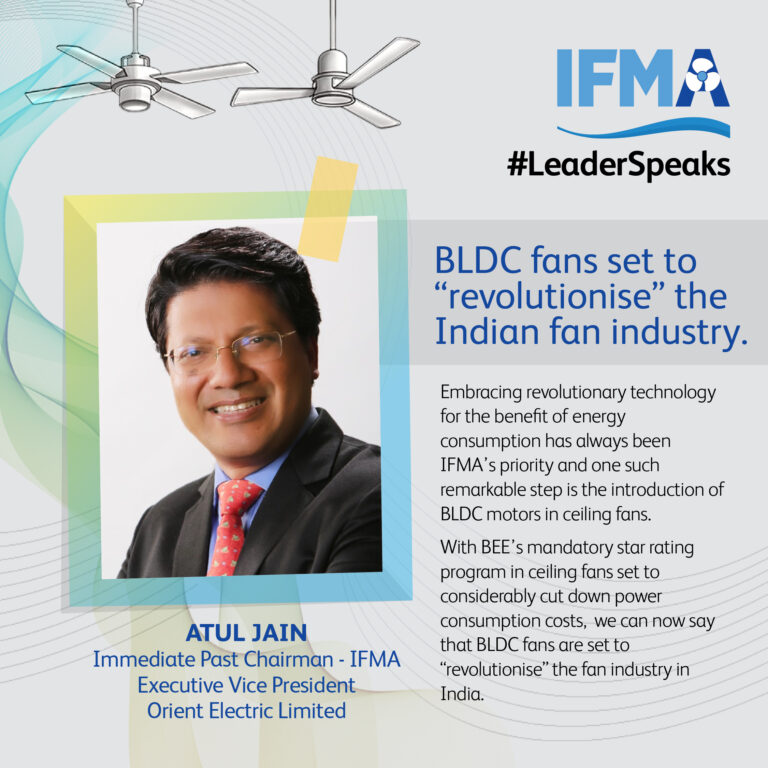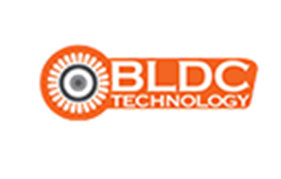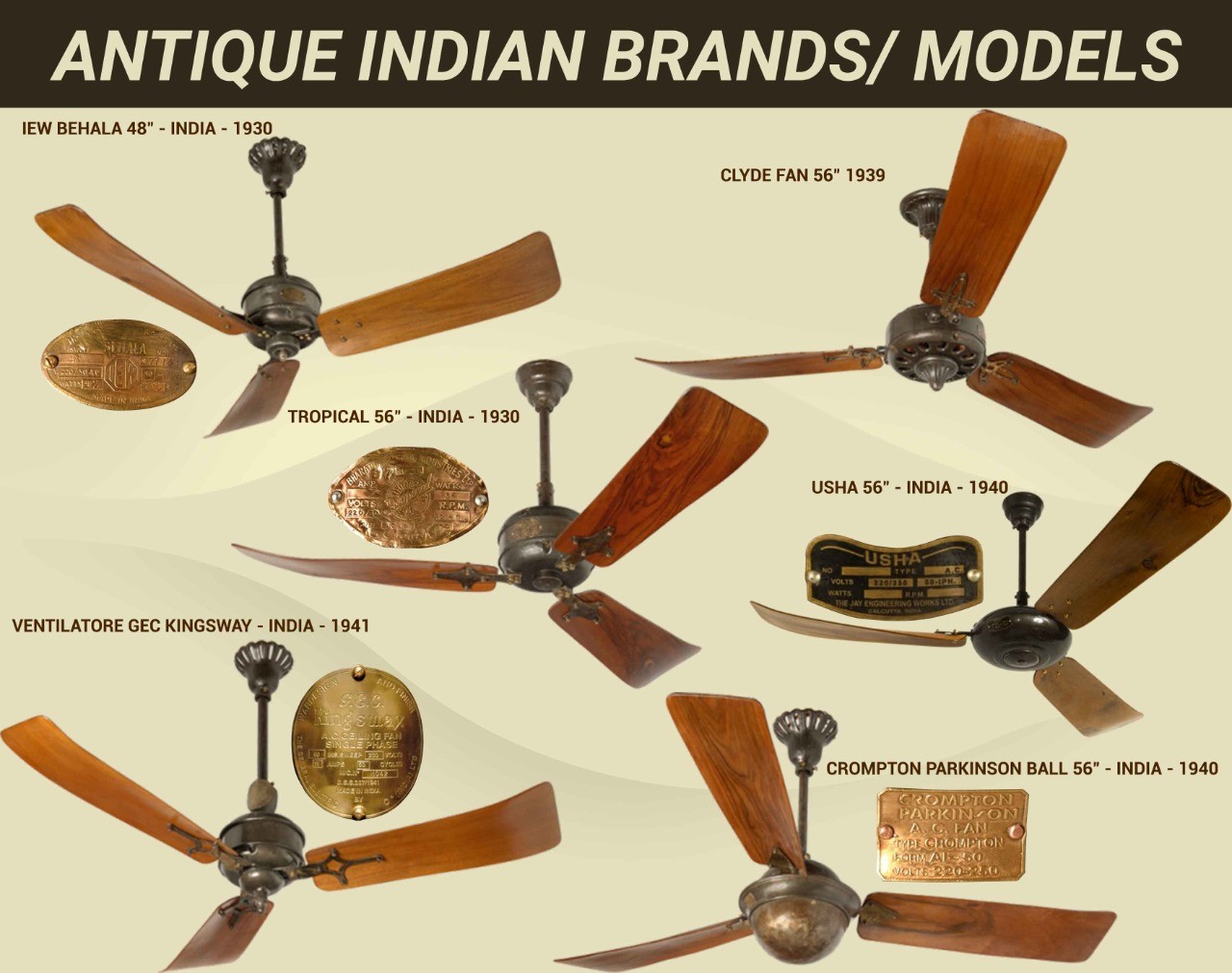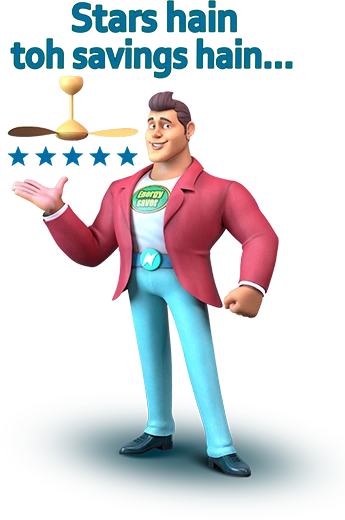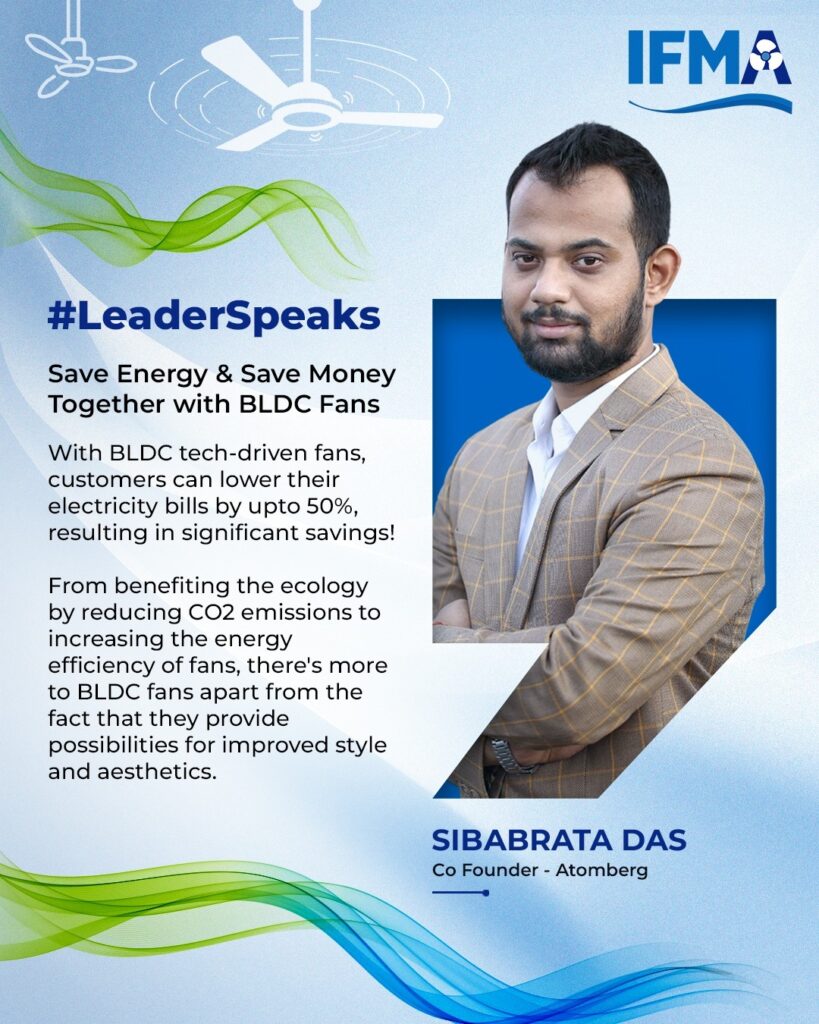
India sees summer temperatures for most of the year. So, fans are a must in any home, business, or industrial setting. However, the fan industry is known for being a low-tech industry, and very little new technology has been adopted or developed over the past four or five decades.
The only changes that we have observed in the past 20 years or so have been in the decorative embellishments or colour tones of this low-interest commodity. But that is no longer the case now. After being seen as a low-tech product, fan motors are now gaining respect, thanks to the introduction of modern BLDC motor technology. All for the good of the nation, the planet, and the customers.
Let me elaborate further by mentioning that more than 7 crore fans are sold each year, adding to an industry valued at more than 10,000 crores and growing at a rate of more than 8-10% yearly. About 65% of these 7 crore fans are ceiling fans, which are energy-guzzlers that require 76 or 85 watts of power for a typical 1200 mm fan sweep. Now that the alternative BLDC (Brush Less Direct Current) motor technology is growing in other applications, energy wastage can be considered a crime.
Furthermore, we’ve noticed that customer preferences are ever-evolving. Over the last ten years, customers have become more aspirational and conscious of energy wastage, pollution, and the distinctive design of home appliances.
Following our graduation from IIT Bombay, we founded Atomberg as an engineering firm to address a variety of consumer issues. The fan industry’s aforementioned results sufficiently inspired us to concentrate on using technology to resolve the many issues of our customers.
Over the past ten years or so, the industry has evolved, the supplier ecosystem has expanded, government policies have changed, and public awareness of BLDC technology and its advantages has increased. These developments have been made possible by the innovative spirit of startup companies like ours & Versadrive along with the drive and participation of the larger incumbents.
With BLDC tech-driven fans, a customer can lower his electricity bill by about 50%, resulting in significant savings! Moreover, it will aid in lowering CO2 emissions, benefitting the ecology as a whole. The BLDC motor not only increases the fan’s energy efficiency but also provides possibilities for improved style and aesthetics. Features like the intelligent & sleek design and the remote control options have become favourites among consumers.
With all these advantages, customers are starting to shift from current fans to BLDC fans. The industry’s compound annual growth rate is currently projected to soar, and 20% of the market has already shifted to fans with BLDC motors.
What’s the future of the Fan Industry?
“Bright” is how the industry gazers describe it, and we think the BLDC share will continue to increase, benefiting not only the consumers with better products but also serving the country and planet Earth.
In the dynamic landscape of the Indian fan industry, valued at approximately Rs 10,500 crore, we witness the participation of around 200 entities, including 14 prominent branded players.
The recent transition to energy ratings entails cost implications that need to be transferred to consumers. Historically, fans had an average consumption of 78-82 watts, but with the implementation of revised norms, the consumption has significantly decreased to 55 watts and below. Notably, fans falling into the five-star category now exhibit consumption as low as 30-35 watts, indicates a substantial shift with a remarkable 50% reduction in power consumption.
Some transformative trends reshaping the Indian fan industry are:
Regulatory Shifts and Consumer Behaviour Transformation: The Indian fan industry is experiencing a notable transformation, driven by regulatory changes and evolving consumer preferences. Despite facing challenges, the industry remains optimistic that this shift will revive demand and open up new avenues for growth.
Positive Indicators: Electrification and Real Estate Boom: Encouraging signs emerge for the Indian fan industry with the surge in electrification and a thriving residential real estate market. These factors contribute to a positive outlook, suggesting potential opportunities for the industry to capitalise on.
Energy Efficiency and Government Vision: The industry aligns with the government’s vision of reducing energy consumption, with a focus on energy-efficient products. The recent transition to energy ratings has significantly reduced fan power consumption, emphasising the industry’s commitment to sustainability. Despite initial challenges, positive consumer responses indicate a promising trajectory.
With a resilient response to initial hurdles and a positive consumer reception, the industry stands poised for a shift from commodity to premium, meeting the changing preferences of consumers. As the industry anticipates a seasonal uptick in demand, the upcoming summer promises to bring a breath of fresh air, not just for fans but for the entire industry, painting a picture of a cool and prosperous future ahead.
In a world where energy conservation is the need of the hour, the Indian Fan Manufacturers Association (IFMA) has geared up and is supporting the BEE and GOI initiative of Mandatory Star Rating programme for Ceiling Fans .
In the upcoming AGM 2023 of IFMA on 4th Sept 2023 the theme has been aptly kept “Stars Hain Toh Savings Hain” to propel the activities to support this initiative .
It would be a sensible guess that 70 to 90 crore power hungry ceiling fans would be at work in our country. Its time to change . Not because of fans being old but because changing to Star rating fans will reduce energy consumption. There will be Savings and benefits all around. From a household to the mother planet.
A household can save upto Rs1500 to 1800 per fan on electricity bill in a year with 5 star fan .Thats big. A massive 284 Terawatt-hours out of the total 1411 Terawatt-hours are consumed by fans alone in India.That would be in savings zone
The energy footprint will be halved, reducing the 284 TWh to a mere 142 TWh. This is not just about saving energy –
Picture a world where electricity consumption slashes by a remarkable 50%, CO2 emissions reduces by an astounding 50 million tons, and coal consumption shrinks by a significant 18 million tons. A sustainable future will no longer be a dream but a tangible goal within reach.
it’s about saving our environment too.
The star-rated appliances are already a game-changer in the world of appliances. And now, it’s set to create waves in the fan industry too. With resounding support from the Government of India, this campaign is poised to enlighten consumers about the immense benefits of opting for star-rated fans.
The star rating program is making its mark, having become mandatory for ceiling fans from January 1st, 2023. IFMA’s unwavering support is evident in this roundbreaking initiative, ready to bring about a technological revolution in motor advancements.
But what’s a movement without a charismatic voice? Enter Mr. Energy Saver, the friendly face of energy efficiency, unveiled at our recent AGM. Mr. Energy Saver isn’t just a mascot; it’s a symbol of empowerment. It’s the voice that bridges the gap between knowledge and action.
The time for change is now with every breeze carrying not just comfort, but whispers of change & sustainability too.
The “Stars Hain Toh Savings Hain” campaign isn’t just a movement; it’s a beacon of hope. It’s an acknowledgment of our responsibility to the environment and our commitment to a sustainable tomorrow.
Join us on this exhilarating journey of transformation, where every star-rated fan becomes a catalyst for change. The stage is set, and the stars are aligned. Let’s embark on this journey of change together.
Get ready to witness the stars – and savings – shine at AGM 2023!
Frequent storms, torrential rains, flash floods, severe droughts, fierce wildfires, and the list goes on. Climate change has started to impact human lives more evidently and severely. This has drastically changed consumers’ sentiments and their ways of purchasing and interacting with the products. They are becoming more conscious of their purchases and consumption. One such stark transformation we can experience today is in the space of transportation, consumers are adopting more eco-friendly electric vehicles instead of fossil fuel guzzlers.
This shift will be experienced in the Electrical consumer durables space too and ceiling fans are one of those. But even though ceiling fans are arguably the most ubiquitous electrical device in Indian homes and businesses after electric lights, they are rarely discussed in conversations about energy saving. As a result of this oversight, a considerable possibility for energy savings has been lost. Fans utilize nearly 20% of the electricity in Indian households, and their use is steadily increasing. In India, total organised fan production is around 60 million units per year. After deducting 30% for table and pedestal fan sales and exports, annual ceiling fan sales in India are estimated to be around 45 million.
Thus Ceiling fans have a lot of potential for reducing power consumption. Thanks to a technology known as Brushless DC Motor, or simply BLDC motor. This technology is on the verge of causing a paradigm shift in the ceiling fan business. In general, BLDC technology has been on the market for a few decades and is widely used in industries that require high torque motors. What has been missing for a long time is its use in ceiling fans. Induction motors are used in classic fans, and they normally consume 70-90 watts. The power consumption of a BLDC fan, on the other hand, can be reduced by up to 65 percent. Other advantages of using BLDC fans are longer backup on inverters even on Solar, increased reliability, decreased noise production, and longevity of the motor.
The market share of BLDC fans is expected to grow exponentially in the coming years. With the declining cost of electronics cost of manufacturing, BLDC fans cost will reduce significantly. BLDC motors are becoming more popular also due to industry demands for lighter weight, smaller size, and higher power density. The cost of BLDC fans is more, but when we consider the rising cost of power, choosing a super-efficient 5-star rated BLDC fan makes a lot of sense. With the BEE making the requirements for achieving a 5-star energy certification more stringent, the newest rated models are exceptionally energy-efficient, utilizing only 25-35 watts of power.
Looking at the shifting consumer centricities, government policies, and building a sustainable environment adoption of BLDC fans is set to grow. Consumers are also more aware and are shifting towards more eco-friendly ways of living. Due to shifts in ways of working, WFH, and hybrid cultures the interaction with fans as a commodity at home has changed. Consumers want fans that are more premium and provide them savings. As said by Wendell Philips “Revolutions never go backward”, this revolution of BLDC fans is set to change the fans industry radically and bring a wave of highly efficient eco-friendly fans.
As the saying goes, the Stone Age did not end because we ran out of stones; we transitioned to better solutions. The same opportunity lies before us with energy efficiency and clean energy. – Steven Chu
Energy Efficiency simply means using less energy to perform the same task – that is, eliminating energy waste. Energy efficiency brings a variety of benefits like -lowering household costs and the whole economy, reducing demand for energy imports and reducing greenhouse gas emissions.
India’s leadership for energy efficiency has been greatly strengthened through the years. With the Prime Minister setting an aim to make India energy-efficient by 2047, various initiatives are being taken by the government to advance the regulations that reduces and transforms energy consumption.
IFMA, the Indian fan manufacturers association is also committed towards the vision of energy conservation and has whole heartedly welcomed and embraced the mandatory BEE (Bureau of Energy Efficiency) star rating program for ceiling fans from July next year.
IFMA has embarked on the same without compromising on the basic parameters like Air Delivery and other parameters which are of paramount importance to a consumer. IFMA members and other fan manufactures are confident about the success of this BEE initiative thereby ensuring that Indian consumers would be catered and served by genuine and serious manufacturers whose vision are in sync with the Global vision.
It has also been observed that over the years, the consumer purchasing behaviour has changed. They are now not just looking for basic fans but models that are aesthetically in sync with their home decor, high in performance / durability and energy efficient. Because of this behavioural change BLDC motors in Fans being energy efficient are also becoming extremely popular. Due to urbanisation and increasing ‘purchasing power’, it is estimated that the number of individual households and the number of appliances in every household will keep increasing. This phenomenon would make it imperative for all appliances especially fans to be power efficient and would be in complete ‘synergy’ with the BEE and IFMA combined initiative.
IFMA commits to be the frontrunner in embracing sustainable and energy-efficient technology and ensuring effective implementation of all Government initiatives especially the BEE Star labelling requirements.
Relying on the new age, aesthetics, and innovation & technology and now energy saving, it can be summarized and concluded that the fan industry is indeed entering in a “golden era”.
The invention of the electric ceiling fan is one of the major milestones in the history of mankind, and it all began in the late 19th century when the first electric fan was invented in the USA. Later, during the early 20th century, companies such as GE Westinghouse, Emerson, and a few more started producing electric fans on a mass scale, and by the 1920s electric ceiling fans became commonplace in the US.
But that’s about America getting their first electric fans. What about India?
When did fan manufacturing begin in India?
And when did India get its first electric ceiling fan?
Well, the history of electric fan manufacturing in India is not well documented, so it will be difficult to put an exact date and chronology to that. But let’s say that it all began in the 1930s and by the 1940s quite a few established manufacturers started manufacturing electric fans in Calcutta.
Come, let’s take you on a journey that gives us a glimpse of some of these pioneers of Indian fan manufacturing who led this revolutionary change from the mid-19th century to the late 1950s.
The Pioneers of that era
Several prominent names such as Clyde, IEW (India Electric Works), Orient, Usha, Kassels, Crompton Parkinson forayed their way into manufacturing electric fans in India. The range of Fans included Ceiling fans, table fans, and Railway carriage fans apart from Air Circulators for Industries
While most fan manufacturing companies started production during the 1930s and post that, here is an interesting fact shared by a writer in one of his blogs. According to him, Kshirode Bihari Chakraborty, a Bengali entrepreneur, set up Clyde Engineering Company Ltd, an electric fan manufacturing company, in the year 1918. By that account, he becomes the father of the Fan Industry in India unless contested. The writer also mentions that Kshirode Bihari Chakraborty was encouraged and financially supported by various native aristocrats that included the likes of Kumar Arun Singha of Paikpara and Maharaja Rajendra Kishore of Mymensingh, to set up this company in Calcutta. This is not yet contested but Yes, Clyde Fans were surely one of the early entrants.
IEW (Indian Electric Works) was another major player involved in manufacturing electric fans in India during the early 1930s. They gave India some robust electric fans that came with sturdy motors. In fact, you would be surprised to know that some of these fans are still in use at the Southern Indian Railway stations.
Orient Fans, which is currently a leading Fan Brand in India, is one of the very few pioneers of Indian fan manufacturing that not only survived over the years, but is thriving to date. The company dates back to the 1930s and it is evident through the newspaper ad that has a picture of Netaji Subhash Bose endorsing these fans that were used in the AICC pandal in Calcutta in October 1937. Interesting, Isn’t it?
The company manufacturing Orient Fans was later sold off to Birla’s in 1940’s and is still one of C K Birla’s flagship company.
Then there were Kassel Fans that are said to have been manufactured by Indian medium-sized manufacturers. Later it merged with Bajaj Electricals and even today some models remain in Kassels Brand in Bajaj fans portfolio.
Some other prominent names that contributed to the introduction of electric fans in India are Usha fans. The company was started by Sir Shriram a leading North Indian industrialist of those times. Initially started as a sewing machine company, they later started producing electric fans in 1946. This is also one of the early brands going strong till today.
The other major player was Crompton Parkinson, a subsidiary of the British company Crompton Parkinson which was taken over in 1947, by Mr. Karam Chand Thapar, founder of the Thapar Group and up to recently was in their fold as Crompton Greaves. Now it has changed hands but Crompton fans even today enjoy the premium-ness of yesteryears.
Another brand manufactured in Calcutta was POWER which was exceptionally well known for its DC ceiling fans (remember some generation and distribution of power supply was still DC till 1950’s). Later in the early seventies, the company along with their other brand Polar was sold off and is still on the market.
Sure, some of the old established names like GEC fans along with IEW, Clyde have been swept away with the passage of time but each one of them had an important role in the industrial revolution of Fans.
Concluding Remarks
While the details are still available and we could gather some historical details of the Calcutta origin of fans but up north in Amritsar too, a revolution happened in the fan industry. Most of the 100 odd manufacturers were small and tiny scale workshops born out of the partition of India and Pakistan. The numbers kept going down after 1950’s as they focussed only on North India and without any Brand building initiatives.
Few like Laxmi in Ludhiana (who also made Sewing Machines.) and Hero Fans in Amritsar (no relation to Hero Cycles) continued for some time.
In fact, the hugely popular Farrata fan (pedestal fan for rugged use) is a gift of the Punjab industry to the nation.
Recent Post
Categories
Tags
Bladeless Ceiling Fans BLDC Fans BLDC Motor Ceiling Fans Ceiling Fan Ceiling Fans Dual Blades in Portable Fans Energy Saving Fans Fan Blades Fan Inverters Fan Regulator Fans Fans are Covid-19 warriors Guide to Buying Ceiling Fan History of Electric Fans History Of Fan IFMA IFMA Editorial Indian Fan Industry Induction Motors Ceiling Fan LED Ceiling Fans Low Noise Ceiling Fans Pankahs Pankha Museum Pedestal Fans Portable Fans Remote Control Fan Remote Control of Fans Star Rated Ceiling Fans Unique Blade






